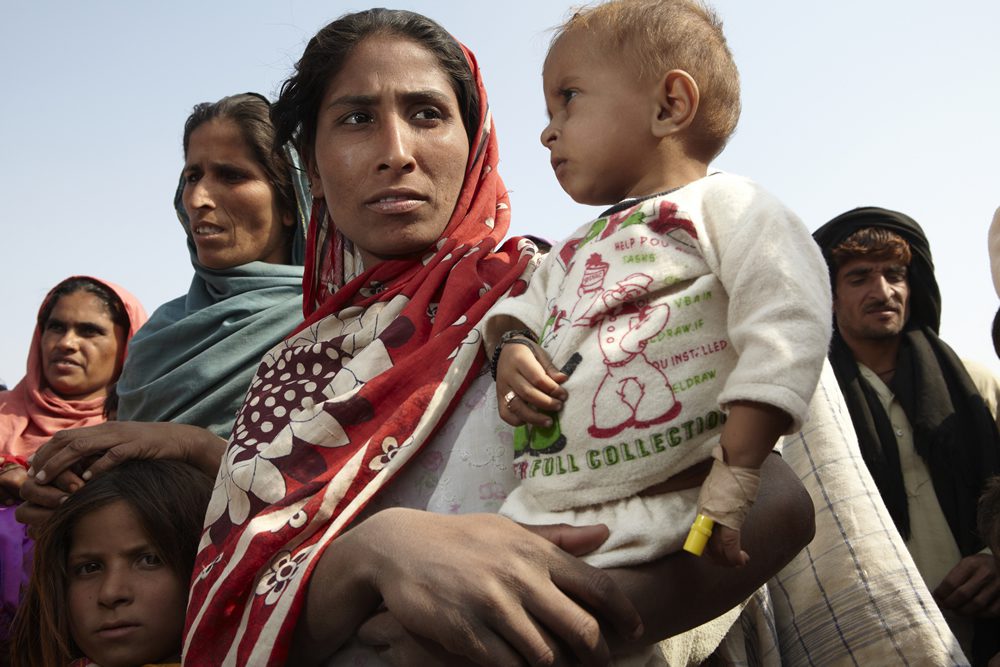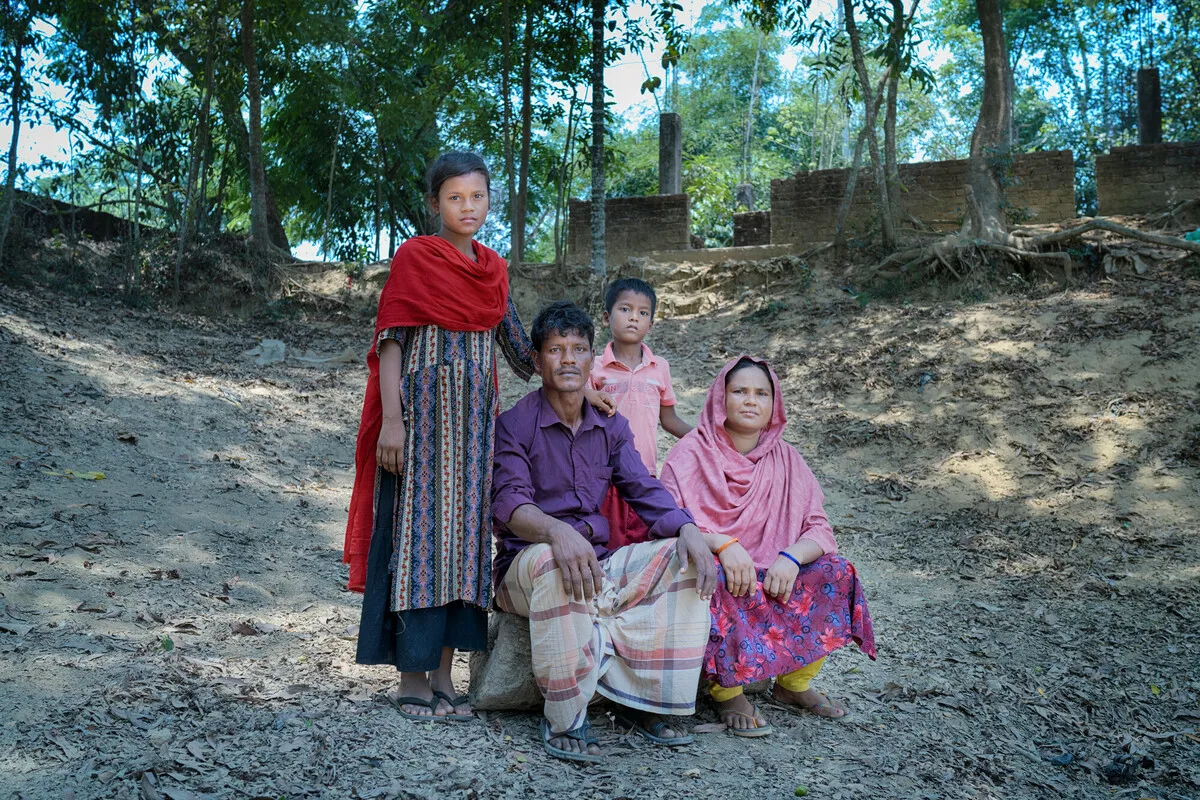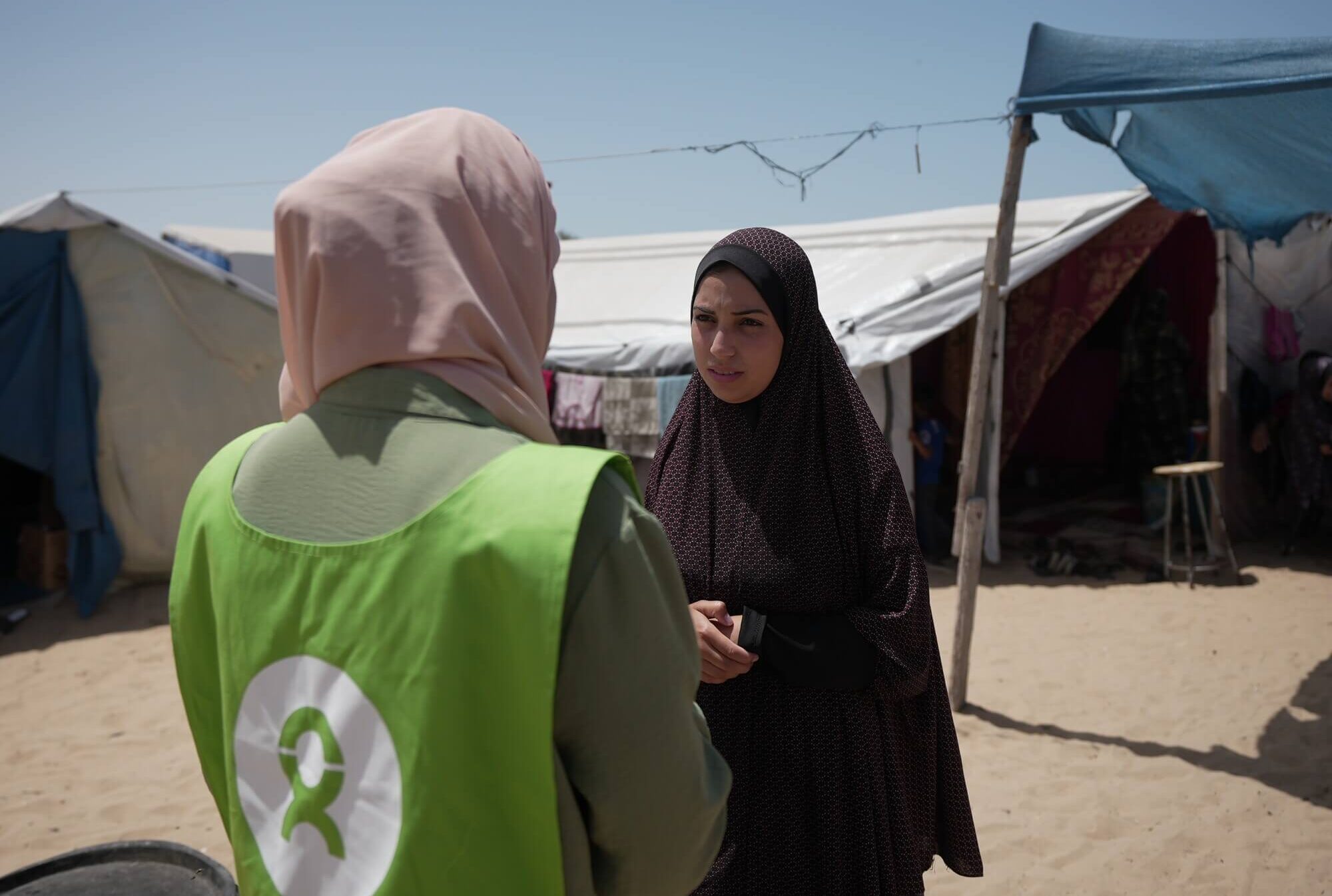By Alex Renton, originally published in The Times, 5/3/2011
After a few days in Dadu, you begin to forget that there is more to the world than mud and mist. It is a place of horizontals – great plains of grey water in a lattice of banks and causeways, some of these studded with sagging tents that stretch in single file for kilometres. The occasional cobweb–hung tree or a drunken telegraph post are the only things that push upwards into the fog that drapes the Indus valley. Villages look like sand castles after the tide has been and gone. This was some of the richest farmland in South Asia. But last August it drowned.
As we pick our way along the causeways we meet people, survivors, wrapped from ankle to eyes in muddy blankets against the damp cold. They are all waiting for something better to happen. Each of them has the same questions: can you help us? When will you help us? How long must we wait? But for many the most urgent thing seems to be that you should hear their story.
“I was a farmer. Now I’m a fisherman,” is how Mumtaz Ali’s begins. When we met him on the embankment he was holding up the fish he’d just caught, with a grin as proud as any canal-side angler’s. He put on a serious face for the camera, because, as he said, this was now his crop – the only harvest from his fields since July last year. Where the winter wheat should be sprouting the fish now swam. The came with the floods when they swept through Pakistan at the end of last summer, engulfing an area bigger than England and tens of thousands of villages like Mumtaz’s. The fish have grown fat on drowned seedlings and the dead livestock.
View photo gallery
[nggallery id=9]
“Fishing does not earn enough to feed our families,” said Mumtaz, “so we are staying here to guard the village while the rest of us have gone to live in camps or gone to the city. My wife and my three children are living on the embankment by the river, gathering wood from the flood to sell for cooking fires.” As we talk a farmer from another village comes to beg the right to take away a few live fish – he wants to breed them in his fields. Mumtaz consents and the man thanks him, again and again.
With four friends, a net and a rickety wooden canoe, Mumtaz makes the only living he can: the catch earns the men 200 rupees a day They sleep in the only building left standing in their drowned village, the two-room schoolhouse. “We are waiting,” he said. Till the water goes away? He shrugs: “Waiting for our life to come back.”
Perhaps four million more Pakistanis are waiting too, in Swat, Sindh, the Punjab and Balochistan – all down the great river plain of the Indus that is Pakistan’s spine. They called it “the slow tsunami”. Three separate floods swept through Dadu district, in Sindh, during August and September, coming from three different directions. The damage across the country was unmatched – 20 million people forced from their homes, 2 million houses destroyed, 5.3 million jobs lost. It was, in terms of numbers of lives affected, the most devastating natural disaster to hit the world in modern times.
Disasters are unfair. It is the poor that they hurt most – the people without transport to escape, without insurance, without savings to rebuild. Here, in the failing state of Pakistan, some of the poorest people in Asia live. Two-thirds of the rural people of Sindh own no land at all, and their rights over their houses are dubious. Most work as share croppers and day labourers on their landlord’s fields. As people returned to their homes in January, we found hardly a household not in debt and hungry.
The injustice of the flood and its aftermath was clear to see from the causeway where we met the fishermen. On one side were the drowned fields and – in the distance – the hump in the water that was Mumtaz Ali’s village, only to be reached by canoe now.
But on the other side, the land was dry. The green shoots of the winter wheat crop made a bright green veil over the mudm and in the distance the sugar cane was getting bushy. Why the difference? I asked. “That is the land of a rich man,” one of the fishermen said. “The case here is that if you are poor, you must live in the water.”
This explanation excited the gathering crowd of ex-farmers. Some said the landlord had got the state government to drain the land, others that it had never been flooded at all. Then a car drew up, and out got a vast man, well over 6 and a half foot and impressively wide. The men made way – this is the landlord, Sikander Ali, someone whispered. “He is head of the village. He is the man who owns the dry land.”
“We need fertiliser, we need seed, we need food,” said Mr Ali after shaking hands. What of the land that needs draining, I asked. “For that, we need pumps. I’ve asked the district commissioner. I know government has given money to get the floods taken away. It hasn’t happened and I’m going to petition the high court. It is all very, very corrupt. 90 crore rupees (AUD$10.5million) for food rations has gone missing. Meanwhile 50-60% of our people are dying of hunger. We have had no aid for two months.”
With that message delivered, Mr Ali departed. Other men gathered round us to give their views. Some said there had been aid but he had commandeered it: now Mr Ali’s men were selling the aid agencies’ tents to the homeless families at 3500 rupees (AUD$40) each. What’s more, those same men had organised the deliberate blowing of a hole in one of the big embankments, to divert the floods. But many voices disagreed: no, Mr Ali was a good man who’d lost his own home and was doing his best for his clan..
Others agreed that the sabotage had happened, but it had been done by men employed by the member of the state assembly. Or perhaps by the District Commissioner. The crowd got bigger and noisier and in the press people started to slip off the embankment as they argued. The midday sun burnt a hole in the mist, an unaccustomed light flooded the embankment and a stink rose from the opaque water.
The men of the local NGO with whom we were travelling listened as the argument grew. They looked exhausted. “Wherever we go, we hear these stories,” said one of them, a specialist in health and sanitation funded by Oxfam. “People will say what they most want you to believe, what they think will get aid to them. It makes our work more difficult.”
One of the NGO’s trusted volunteers, a farmer named Janeb Khoso, took us to his village so we could talk over what had happened. As our 4×4 wound its way along the causeways, he told me of the evening in early August when the floods came to his village. “There’s a bund [flood protection embankment] near here. It’s very strong. It was built a long time ago, in the time of the British. It held up the flood in 1972 so we were proud of it. We knew no water could break it.
“At 7.30 in the evening, just after dark” Janeb continued, “the people who live close to the bund heard an explosion. The water started to flow. All at once it was like in the middle of an ocean. The people ran for their lives. They couldn’t save anything. Because we are further away, my family had about an hour and so we escaped with a few clothes and some food. But we lost the furniture, the freezer and fridge that we saved years to buy. And we lost our seeds, our investment for this year. Our six buffaloes were drowned.”
He gestured round the village – an island perhaps as big as two football pitches. Around it was mud and great pools of yellow-grey water. The houses looked as though they had melted from above; few had more than a couple of feet of eroded bricks left. Canvas tents and plastic tarpaulins stencilled with the logos of the relief agencies stood among the ruins.
“The explosion? Everyone knows who it was done by.” Janeb named two big local landlords, prominent politicians. “They ordered it to be done to protect their lands and the lands of their people.” The breach has already been mended, trapping the floodwaters on the lands the embankment was supposed to protect. As a result, many of the people of the villages around are still in the camps for the displaced.
Until two weeks ago, Janeb’s village could only be accessed by boat, and he thinks it will be two months more at least before enough water will be gone for a crop to be planted. Even then, the land will need to be cleared or chemically treated, because where the floods have receded they often leave a thick white crust of salts.
“The flood should not have happened here,” said Janeb, shaking his head. “But we didn’t make a complaint about the explosion. We didn’t dare. These are very strong people. They used explosives, after dark – if they had used a machin to break the bund we would have heard and we would have killed the drivers.”
Picking my way around the muddy remains of Janeb’s village I peered into a UNHCR tent that seemed to be stuffed to capacity, wobbling a little. It proved to be full of women, who looked at me with wide eyes. They shook their heads at me when I tried to speak to them and I retreated.
We went to look for women who could talk to a strange man. Driving along the causeways, strange and surreal sights appeared in the fog: a cluster of men, all wrapped round and round in blankets, talking over a snooker table rescued from the floods and set up for a game on the causeway. Dead trees bent and bound like mummies in thick cobwebs: the spiders had nowhere to go but there when the water came. Other men were breaking rocks to repair erosion in the causeways – government or NGO-funded labour designed to get cash into the local economy. It is clearly a sensible idea, but the “cash for work” men shivering in thin shalwar kameez pajamas looked as miserable as convicts on a chain gang. There was a swift way of gauging how poor someone was in Sindh’s near-freezing January: clearly, if you owned clothes, you would put all of them on.
“Most people here don’t have any land,” said Janeb. “Many don’t work now because they can only do labour for the landlord and he would keep their earnings to pay the debts they owe him. And if they work rebuilding their houses, he will say: you should be working in my fields.”
We came to another island-village, Ibrahim Chandio, a hummock above the mud close to the newly-repaired bund. And here we found women eager to talk. The NGO had trained them all as basic public health educators, and their role as providers of water purification tablets and teachers of hand-washing discipline to the village seemed to have invigorated them. Their husbands and sons gathered and watched silently as we talked.
“We came back here in December: we didn’t want to but there was no food any more in the camps,” said 30-year-old Husna Ahmed [purple and orange shawl in pic] The army told us our village was fine, but it wasn’t.” She balanced a snotty toddler on one hip, while her other two children, 7-year old Yasni and 10-year-old Ifan, played around us. There has been no school since before the floods – and the building is now home to three families.
“The water on the road was still up to our knees. We saw our houses and we were amazed: they were standing when we’d left and now they were no more. Tears came to our eyes, and our hearts were heavy with sorrow and fear. We had to sleep outside in the mud.”
I asked her what worried her most. “We are trying to save our children before ourselves, and they need food,” she said. “Many things have improved – the children do not have diarrhoea so much, and they are not vomiting. The NGOs brought us tents and some lentils. The government gave each of us some money, but that has gone. We don’t think the water will leave our land for three or four more months, so how can we earn or grow a crop?”
Malnutrition is a worry for mothers and for those trying to patch the holes in the ill-funded international response to the flood. (According to Oxfam, AUD$406 per head had been donated for victims of Haiti’s earthquake within 10 days. In Pakistan the figure was AUD$3.20) An official for the World Food Programme told me in January he was working on a plan for six months more emergency feeding for thousands villages and camps in the Dadu district. But, one week before the huge project was due to start, it still wasn’t funded. Meanwhile prices were rising – wheat flour for chapattis, everyone’s staple, up 50% on a year ago. Onions had grown so expensive that the week we were in Sindh the government ordered exports of them to stop.
At the end of January, Unicef announced that malnutrition rates in Sindh were at levels more normally seen in crises in Ethiopia or Sudan. 23% of children had severe acute malnutrition, of the sort that would leave their brains and bodies permanently damaged. At one camp a doctor from Medecins Sans Frontieres said that 13% of children were malnourished in Sindh at the best of times. “This is a very, very poor place.”
Poverty like that is a trap without much in the way of escape. Pakistani development experts make the point that, for all the talk of “building back better” that has accompanied the Pakistani government’s praised response to this vast disaster, there’s not much you can do to improve the lot of rural people who own no land. Except to give them some. Land transfers, reform of land ownership rights and indeed the break-up of the feudal system that runs rural Sindg, are much discussed. But these measures hardly feature in either the World Bank-sponsored recovery plan for the floods. “This form of agriculture needs poverty,” one analyst said to me. “There’s a lobby that wants to keep rural labourers landless and poorly educated, because that’s how a landlord can get rich.”
For some of Sindh’s washed-out poor, there will be no going back. In a large camp on a cold desert plain outside the southern city of Hyderabad I met villagers from Dadu, all of whom had decided to abandon their ancient life of rural labouring. “Go home?” one fierce old lady said to me outside her tent. “No! The water is still there, the smell is terrible, we don’t have any way to make any money, and the landlord has told us he wants to be repaid for the crops that were swept away by the flood. He says that’s our fault!”
The speaker was Murdam Jakhrani, a grandmother of 28. Her grandfather lost their land near Jacobabad in Dadu districc in a family fight, and ever since the family has worked for a share of the crops they plant and tend for a landlord who advances them the cost of seed and fertiliser. “He is a rich man, He lives in the city,” said Mrs Jakhrani. When the floods came the landlord asked for 40,000 rupees (AUD$465) to rescue the family by truck from the water. “It would be a blessing for all our lives if we got some land. It would change everything. But when this camp closes, we will go to the city to beg. That will be better than going back.”
Read more about Oxfam’s response to the Pakistan floods
Donate to our Pakistan floods appeal



